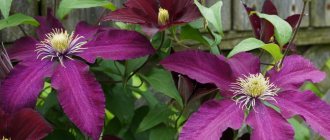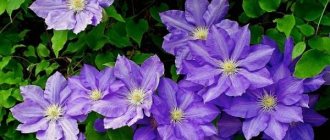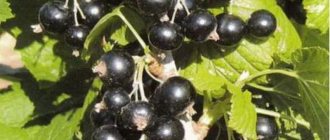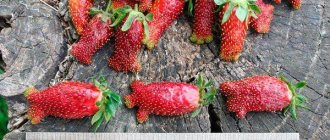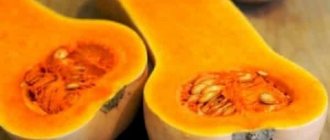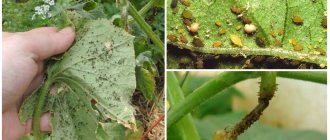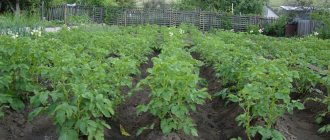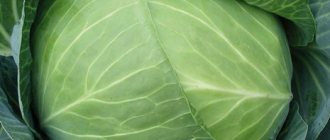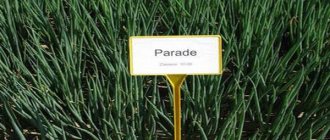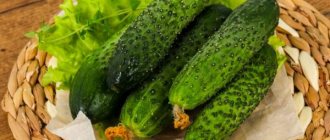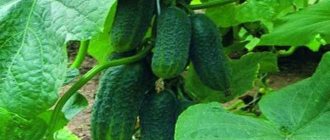Plants » Flowers
0
207
Article rating
Kira Stoletova
Thanks to its unusual external characteristics, clematis Princess Diana is the favorite variety of millions of gardeners from different countries. It was bred in Britain through a long selection of Texas clematis. In 1984, the Peveril Clematis Nursery registered a new hybrid, naming it in honor of the beloved Lady Di.
Clematis Princess Diana photo and description
Description of the variety
This is a fast-growing herbaceous vine (clematis), the shoots of which reach 2-2.5 m in length. The leaves are dark green, small, rounded. They are located at a distance of 4-5 cm from each other. They have long petioles, with the help of which they cling to any support - a net, a wall, trees and bushes.
The main pride and decoration of the Diana variety are its unusual tulip-shaped flowers. The petals are long, up to 8 cm, pointed, raised and closed together. The color of the buds is pink-red, with burgundy-brown anthers located inside, but they are almost invisible.
Clematis smells very tasty. The aroma is especially intensified in the evening and early morning.
The flowering period is not too long - from June to August. It does not bloom again even in southern latitudes, but the bush still looks attractive. Until the frosts, it is decorated with decorative fruits - bright berries. However, the seeds do not have time to ripen and are not suitable as planting material.
Description
Clematis variety "Princess Diana" was bred in 1984 by British breeders, as can be easily guessed by the name of the plant. It is distinguished by ease of care, unpretentiousness, long flowering and extraordinary beauty.
The pride of clematis is its flowers.
For their sake, gardeners are constantly growing new things to enrich the area with unexpected colors. 'Princess Diana' has bright pink flowers with yellow stamens in varying shades, from cream to deep rich yellow. The diameter of one vine flower is 5-7 cm, the shape is funnel-shaped in the form of tulips pointing upward. Each flower consists of 4 petals with pointed tips. The flowers look original and unusual, so gardeners are happy to use the “Princess Diana” variety to decorate gazebos, terraces, fences, and pergolas.
In addition, clematis flowers exude a light, delicate aroma that very gently saturates the air.
A very interesting feature of the clematis variety is that in autumn and winter it is decorated with decorative fruits.
Liana "Princess Diana" stands well on supports and grows well.
The height of the bush is 1.0 m - 1.5 m. The plant is compact and versatile. It is completely undemanding in terms of soil composition. Often grown in containers.
The flowering period is from June to September; all summer long, the areas display a riot of color from the original luxurious clematis flowers.
"Princess Diana" prefers a place protected from the wind, with good lighting and moisture permeability for planting. For “Princess Diana” you need to provide enough sunlight - at least 6 hours a day.
The variety of vines “Princess” is a perennial plant. Therefore, in addition to the usual care measures, it is necessary to maintain regular pruning and cover the bushes for the winter. After proper pruning of the vine, the number of shoots increases annually.
Gardeners like this variety of clematis because it is easy to prune.
Attention! It belongs to the third group of pruning.
Landing Features
The variety has high resistance to frost. With good shelter it can tolerate winters down to -45 °C.
Clematis princess diana reviews
Clematis is planted both in autumn and spring. In the second case, the seedling will have more time to take root, but it will bloom a year later.
Autumn planting is preferable, but only if the plant is healthy and has a good root system.
Selecting a location
Clematis loves bright places with occasional shading. For example, he will be comfortable under the shade of a large fruit tree or against the southern or southeastern wall of the house. The hybrid is afraid of strong winds, the bush must be protected from them, especially for the first 2-3 years.
In constant open sun, the roots will dry out and overheat. This is unacceptable, the Princess Diana variety is prone to diseases due to lack of moisture, and its delicate foliage can wither in the bright sun, and the buds may crumble or not set at all.
Preparation of planting material
Seedlings purchased in a store or sent by mail must be carefully inspected.
Cuttings with dormant buds are usually sold in special bags with peat or a clod of earth. They should be placed at the bottom of the refrigerator and kept there until new shoots begin to grow. From this moment the seedling is ready for planting in the ground.
Cuttings with branches and leaves are purchased 10-14 days before planting. They are stored in a cool place and then planted in the ground.
Immediately after purchase, you cannot assign the plant to a new place in the garden - it will be quarantined. During this time it will become clear whether it is healthy.
A healthy seedling is bright green, with clean bark without plaque, growths or spots. The leaves are uniform in color, smooth, without signs of insect activity. The root system consists of at least three roots; they are dense, even, with a white core. Only such seedlings are planted in open ground.
Landing technology
The hole for the bushes is prepared in advance. The Princess Diana hybrid has relatively developed roots, so the dimensions of the pit are approximately 70x70. Multi-layer drainage must be laid at the bottom, especially if groundwater passes under the bush.
Clematis texas princess diana
In this case, there is a high risk of rotting of the plant roots, so drainage consists of:
- stones;
- large expanded clay;
- crushed clay shards;
- river sand.
Nutrient soil from leaf soil, humus, compost, and peat is laid on top of the drainage. If the acidity is high, it is reduced with dolomite flour and ash. Ideally, the variety prefers neutral soil.
The seedling is placed on the ground. Straighten the roots and sprinkle on top. Planting depth depends on the season.
- In spring, the seedling is buried more - 20-25 cm. This will prevent the roots from the sun and rapid evaporation of moisture.
- In winter, it is buried 15 cm deep, but also so that the root collar is underground.
Description of clematis Princess Diana
Clematis is a fast growing plant. Its strong bush can grow up to 2.5 m. The Princess Diana variety has herbaceous shoots and light green foliage.
The pride of any clematis is its flowers. Because of them, many people cultivate new varieties in their garden to decorate it. Clematis flowers of the Princess Diana variety have a rich pink, almost red color. The stamens between the petals are colored in various shades of yellow.
The diameter of the flower can vary between 5-7 cm. It has a funnel shape, like tulips. Clematis Princess Diana has 4 petals with pointed tips and directed upward.
Flowers of this variety have a very original and unusual appearance. That is why gardeners are happy to decorate gazebos, pergolas, fences and terraces with them. Flowering not only decorates the area, but also saturates it with a subtle delicate aroma.
Frost resistance, drought resistance
Clematis Texas Princess Diana is hardy. If you provide the plant with shelter for the winter, it will withstand temperatures down to -45°C.
The variety is very sensitive to droughts and low levels of humidity in the air.
Resistance to diseases and pests
This variety is immune to powdery mildew, but it is extremely susceptible to fungal diseases, for example, wilt. In this case, the plant begins to lose elasticity, dry out and wither.
Clematis Princess Diana can also develop rust. Then its leaves begin to turn brown and dry out. The shoots become deformed.
At the end of summer or early autumn, the bush may undergo necrosis, ascotychosis or cylindrosporiosis.
Among insect pests, clematis can encounter nematodes.
Care
The Princess Diana hybrid is unpretentious, tolerates cold well, but is not resistant to disease. Therefore, you need to care for the plant carefully, carefully monitoring the slightest changes.
Problems with the root system are not immediately visible, and the consequences can be disastrous.
Watering
The variety loves moisture and responds well to frequent watering, especially in the summer heat. In the first year, a young seedling needs to be watered every 3-4 days.
Clematis diana
If the summer is rainy, then it is important not to overdo it with watering. However, moisture during this period is very important for the growth of small roots, without which the plant will not be able to feed.
An adult bush is watered less often:
- in summer - once every 5-6 days;
- in autumn - once every 10-14 days.
It is better to take settled or rain water. In the summer, it is easy to collect it in a barrel on the site, placing it under the roof. Some gardeners water young bushes with warm water, but this is not necessary. On the contrary, seedlings need to be hardened off, then they will survive the winter more easily.
Feeding
The Princess Diana variety is demanding in terms of soil nutrition and regular fertilizing. However, the seedling should not be fertilized for the first year.
They begin to fertilize in early spring, before the buds open. At this time, the plant needs nitrogen. Most of this element is found in urea, urea and saltpeter. They are sold both separately and as part of mineral complexes. One of them is UAN - a nutritious urea-ammonium mixture.
Before flowering, clematis needs phosphorus and potassium. Budding takes a lot of effort, so additional fertilizing during this period is necessary.
The main fertilizers for lush and long flowering are:
- Superphosphate;
- Potassium sulfate or chloride;
- Ammophoska or nitroammofoska;
- Potassium sulfate.
All these complexes are easily absorbed by the roots, give strength before flowering, and increase immunity. The main thing is to apply strictly according to the dosage indicated in the instructions.
Ideally, you need to know exactly the acidity and composition of the soil in order to determine which substances the crop needs most.
In the fall, rotted manure is placed under the clematis bush. It is better if it is dry, mixed with straw, hay or sawdust. Such fertilizing will not only enrich the soil, but also improve its structure. The soil will become more loose, soft, and breathable. Organic matter promotes the development of beneficial bacteria in the soil and helps clematis absorb beneficial microelements.
The variety is also fertilized with home remedies. For example, tea leaves or coffee cake. If you dig them into the top layer of soil, you will get an excellent mulch. Potato broth, which contains a lot of starch, is useful. Regular sugar is also suitable for feeding the plant - it is simply scattered under the bush or watered with sweet water.
It is very good to fertilize clematis with herbal infusion, especially nettle starter. It is prepared simply - cut nettles into a barrel, fill it with water and leave it to sour under the lid for a month. When the infusion begins to foam, water the plant with it. Sometimes yeast is added - it is also beneficial for flowers.
Loosening and mulching
The roots grow parallel to the surface, shallowly, and really need constant access of air.
Princess diana clematis
It is necessary to loosen the soil under the bush - this way it will be healthier and stronger, and flowering will last longer. The main thing is to do this carefully so as not to damage the root system.
Mulch the soil in the tree trunk circle to lighten the soil and also protect the roots from overheating and drying out. Most often, fresh hay or straw is used as mulch. Dry peat also works well.
Sawdust is allowed only in spring and summer; it cannot be placed under a bush for wintering. When wet, they are strongly pressed, become dense and heavy, and freeze in winter.
Low annuals are often used as mulch. They are simply planted under a bush and left there until autumn. Flowers will prevent other weeds from growing, protect the roots of the clematis, and also prevent pests from attacking it. For example, marigolds and calendula perfectly repel various insects that harm clematis.
Trimming
The Princess Diana variety belongs to pruning group III - the most convenient for beginning gardeners. In autumn, the shoots are cut out completely, leaving small stumps with 3-4 buds above the ground. New vines will then appear from them in the spring.
Some clematis lovers do not cut them off completely for the winter, leaving a few shoots for the winter. This makes no sense - this variety produces buds only on fresh, young shoots.
The bush is pruned just before frost, when the bush has already completely lost its leaves. It is imperative to treat the cut areas with a fungicide (Fitosporin) and cover with activated carbon.
Cut shoots are used as a “cushion” to cover the plant for the winter. They should be dried a little first.
Shelter for the winter
Princess Diana is a frost-resistant hybrid. In southern latitudes it is not even always covered, and the plant overwinters well under the snow.
Clematis princess Diana
In the middle zone or more northern regions, the bush needs shelter. There are several ways to organize it:
- After pruning, the stump sticking out of the ground is covered with spruce branches, non-woven material is placed on top and the whole thing is covered with film. Bricks or stones are laid along the edges to prevent them from being blown away by the wind.
- The cut clematis is covered with dry manure, a layer of dry foliage is thrown on top and covered with sponbond.
- The planting site of the bush is simply covered with dry straw and a sheet of slate on top.
Important! In spring, you should not be late in removing the cover from clematis. Its roots can rot from excess heat and moisture. This is especially true if a film was placed on top.
Clematis care
Princess Diana is sensitive to drought and therefore needs special care.
Watering
Like most types of clematis, Princess Diana likes moisture. Due to insufficient watering, flowers will decrease in size and foliage will wither and fall off. Watering this plant is necessary depending on its age and weather. A young bush needs one watering every 7 days. During hot periods, the number of these procedures should be increased to once every 5 days.
Top dressing
During the first year, the plant does not need feeding, as this can lead to rotting of the root system. Then you need to start adhering to the following scheme:
- in the spring, fertilize the bush with nitrogen fertilizers and water with lime milk;
- in the budding phase, feed clematis with potassium substances;
- after flowering, use fertilizers that contain phosphorus;
- After summer pruning, apply complex mineral fertilizer.
Mulching and loosening the soil
Mulching can partially replace watering and loosening activities. This procedure ensures the structuring of the soil by breeding worms in it. In winter, mulch protects the root system from low temperatures that can damage it.
Without mulching, the soil will have to be loosened daily in the tree trunk area, and weeds will also have to be weeded out.
Trimming
Clematis Princess Diana belongs to the third pruning group, which is very convenient for those who grow it. The shoots must be pruned several times during the growth and development of the plant. In the autumn, you should cut everything almost to the surface of the soil, leaving only about 10 cm. In the spring, there will be more shoots, and the bush will become lush.
Preparing for winter
You should begin preparing the plant for wintering when the first night frosts arrive. First, you need to hill up the base of the shrub with a layer of approximately 10 cm. To do this, you can use garden soil or compost. After this, you should spray the soil near the plant with a fungicide solution and sprinkle with ash.
Sheltering shrubs for the winter
To cover clematis for the winter, simply cover the shoots with a wooden box and throw dry leaves on top.
Diseases and pests, methods of control and prevention
Clematis variety Princess Diana is not immune to wilting. This disease appears in the root system of the plant, so it is extremely important to follow the watering schedule. This is the most important preventive rule.
In May, it is necessary to remove the affected areas; this should be done along with part of the soil. If the disease is mild, the bush needs root watering with Fundazol.
For prevention against powdery mildew and gray mold, it is necessary to use Azocene.
Spraying with copper oxychloride or Bordeaux mixture will help against rust.
To cope with diseases such as ascotychosis, necrosis and cylindrosporiosis, a solution of copper sulfate should be used.
To prevent the invasion of nematodes, it is necessary to properly prepare the soil for planting and not stray from the watering plan.
Reproduction
The hybrid is propagated in several ways. Each of them is simple and allows the new plant to retain all the varietal properties of the mother plant.
Clematis Diana photo
It is better to start the clematis propagation procedure in the spring, when the winter sleep is over and active growth of the bush has begun.
By layering
The outermost shoots are bent to the ground and dug in so that the top remains on the surface. To be sure, secure the branch with a stone or brick. Water the soil periodically so that roots form quickly. Some people build a greenhouse over the shoot, but this is not necessary.
The cuttings take root in about a month. Success depends on air temperature, watering regime, soil type and the age of the bush itself. Some old clematis produce root shoots on their own. Young shoots begin to grow next to the main bush. They are also planted, just like layerings that were forcibly rooted.
Cuttings
The most common method of propagation of clematis. Cuttings are cut in the spring, when young vines are just beginning to grow.
2-3 buds are enough for rooting. It is possible to do this in water, but it is better to place it in the ground. This way the plant immediately adapts to the growing conditions in the soil without the risk of dying during transplantation.
The cuttings are placed at an angle in light soil - this will make it easier for the roots to grow. At a temperature of +27 °C and with frequent watering, the cuttings will take root quickly - in 2-3 weeks. Then new leaves will begin to grow. Already in the fall, the young plant is transferred to a permanent place in the garden, or you can wait until next year.
Dividing the bush
Adult and old clematis bushes - older than 8 years - are subjected to this procedure. They are very thick, bloom poorly and need to be replanted.
The bush is dug up and cut into separate parts with a knife or shovel. One can produce up to 6 small plants.
After division, the main trunk is returned to its old place, having previously updated the soil. The rest are planted separately.
Methods for propagating clematis
This variety can be propagated using three methods:
- Dividing the bush. The root system of the plant should be divided with a knife or pruning shears. After planting, it is necessary to trim the shoots to two buds.
- Rooting cuttings. To do this, the vine shoot needs to be placed in a small groove, the depth of which is 7 cm, and pressed against the soil. Next, it is sprinkled with earth, but the upper part of the vine layer should be left open. Next spring, it is necessary to separate the young vines from the mother bush.
- Cuttings. On the cuttings of the plant you need to leave an internode and two buds. This material can be rooted in plastic cups or directly in open soil.
Diseases and pests
The Princess Diana hybrid is often susceptible to diseases, especially various types of rot. They develop with excess moisture and lack of lighting. For prevention, you should water the plant in the spring with a solution of the drug Fundazol. Azocene is also good in this regard.
Clematis pruning group Princess Diana
Rust can be easily cured by spraying with preparations containing copper. Copper oxychloride or Bordeaux mixture are the best means of combating fungus. Copper sulfate will help get rid of ascotychosis.
The most dangerous pests are root nematodes. It is impossible to save the bush from them if they have already multiplied in the roots. The plant must be disposed of. But it is possible to prevent the appearance of pests by carefully preparing and disinfecting the soil when planting.
Sometimes the shoots are eaten by caterpillars. It’s easy to cope with them with the help of the drugs Lepidocide and Biotlin. Every morning you need to inspect the plant and collect insects by hand. The same goes for slugs. If there are too many of them, you can sprinkle the ground around the bush with crushed bricks or shells. Slugs will not be able to crawl onto the bush.
History of selection
Flower growers have been growing Clematis Princess Diana since 1984. It was bred in England and named after Lady Diana. The author of the hybrid is Barry Fretwell. During hybridization, he used representatives of the Clematis texensis group. These varieties have an original flower shape that resembles a tulip.
Other varieties of this group are popular among amateur gardeners:
- Odoriba;
- Etoile Rose;
- Lawrence
They differ only in the color of the petals. All adapt well to any climate zone. They are not afraid of heat or low temperatures. Clematis texensis varieties belong to the 3rd pruning group.
Use in landscape design
Clematis of the Princess Diana variety are used to decorate gazebos; high arches are built, on both sides of which these beautiful flowers are planted. They also cope with wall decor, quickly covering them with a green and then a floral carpet.
You can combine clematis with other climbing flowers. For example, with roses, grapes, hydrangea. By selecting different varieties of clematis and planting them side by side, you can achieve continuous flowering of these beautiful crops from early spring until the first frost.
Reviews from gardeners
Natalya, 43 years old, Danilov (Yaroslavl region)
I have had this variety for four years now. I saw it on someone else's property and just fell in love. I asked the owner for the name, bought a seedling in the fall and immediately planted it. The first year I did not allow the bush to bloom: I tore off all the buds, as I was advised. But in the second summer, clematis repaid my care with lush flowering. Very pleased with the purchase. A wonderful plant, beautiful, and easy to care for.
Suzanna, 39 years old, Svetlograd
I bought the variety because I liked the picture. The bush has been living with me for six years. At first I couldn’t get used to wintering, I left one shoot for earlier flowering, but little came of it. Then I started cutting off the stems completely, and I have no regrets: there are no problems with shelter, and the flowering has improved. I planted clematis near the gazebo so that when it rains, water from the roof does not get under the roots. Every year I plant annuals next to the bush: they are beautiful and the roots are shaded.
Oleg, 57 years old, Bryansk region
My wife's favorite variety. I bought it for her as a gift. It's been growing here for five years now, blooming just before her birthday. If you follow the rules of care, then there are no surprises with him. In the fall I cut it off completely and cover it with mulch. In the spring I simply rake up the mulch, after which the stems quickly begin to grow. There was never any freezing or dampening of the tillering center.
Reviews
Gardeners respond mostly positively to the Princess Diana variety. Everyone likes the unusual flowering of the hybrid and its resistance to frost. Simple trimming also adds “pluses” to the reviews.
The main disadvantage is considered to be the instability of clematis to wilt and rot. However, you can prevent them by carefully observing the watering schedule and placing the plant in the right place.
With a good climate and care, the bush can grow and bloom luxuriantly for a very long time - several decades.
Features of reproduction
Since Princess Diana is a hybrid variety of clematis, the seed material in most cases does not retain the varietal characteristics of the original plant, which means that trying to propagate the vine by seeds is useless .
Varieties of planting material offered by various manufacturers
It is quite easy to obtain seedlings using vegetative methods:
- dividing the bush - gardeners use this option relatively rarely, as it is very labor-intensive. In addition, few new plants are obtained, and the work of separating them from the mother bush is associated with the risk of weakening or damaging it;
- horizontal layering is a simple method that allows you to get several strong seedlings without much effort. It is important to regularly water buried shoots during the summer and mulch this area for the winter. Young bushes are separated from the mother plant and planted at the end of next summer;
- green cuttings - with proper organization of the rooting process, a lot of planting material is obtained.
Growing clematis of this variety is not particularly difficult. This beautiful plant is very responsive to care and deserves to take a place in every summer cottage.
Basic principles of agricultural technology
Like other clematis, “Princess Diana” prefers well-lit places that have protection from strong winds, but does not really like to be in direct sunlight all the time. It is best to plant a young bush so that it is shaded by tall fruit trees for part of the day.
For planting, it is better to choose well-lit places, partially shaded by trees or buildings.
In the southern regions, this variety is best planted in the fall, in early October, and in areas with colder climates - in the spring.
The planting technology is the same everywhere, but the owner of the site must take into account such a factor as the depth of groundwater. If the place is “damp”, it is necessary to protect the clematis roots from possible soaking by pouring a small artificial mound in advance at the site of the future hole
In addition, in any case, its bottom should be covered with a layer of drainage materials (stones, crushed stone or broken bricks).
Clematis does not grow well in acidic soils. If there is a serious problem of this kind on the site, it is not recommended to take soil to fill the planting hole right next to it. It is better to use purchased soil or good humus with the addition of wood ash. When placing a seedling in a permanent place, it is necessary to carefully straighten its roots and ensure that the root collar is located at least 10-15 cm below ground level. This will protect the “tillering center” from the adverse effects of very low or too high temperatures.
It is important to immediately dig in supports for constructing a trellis next to the seedling. In the first year of the plant’s life, it may not be needed, but such foresight will still not be superfluous.
If the young plant was planted correctly, it will need the first feeding only after a year. At the beginning of the growing season (spring), nitrogen-containing fertilizers are applied to the bush, and during the flowering period, a complex phosphorus-potassium additive is applied. Closer to autumn, all fertilizing is stopped, but only in the middle - end of September in the middle zone it is recommended to scatter wood ash under each plant. The additive contains a lot of potassium, and its increased content in the soil helps to increase the winter hardiness of plants.
Starting from the second year of growing season, during the period of active flowering it is recommended to feed the bushes with phosphorus-potassium fertilizers
In summer, the vine is watered once a week (in severe drought, the number of waterings has to be doubled). It is useful to mulch the ground under the bush with compost, humus, or peat on top, 8-10 cm away from the stems. If possible, it would be a good idea to organize a drip irrigation system, since now there are no problems with purchasing the necessary equipment. A good technique to ensure optimal temperature in the root zone is to shade the lower part of the vine with annuals or low bushes planted nearby, but the water consumption when watering in this case must be increased.
Clematis "Princess Diana", according to gardeners, is quite resistant to most diseases, but can suffer from verticillium wilt (wilt). Therefore, when caring for a plant, you should not neglect annual preventive measures (for example, treating the bush and soil above its roots with Fundazol).
In addition, it is important to follow the irrigation regime and monitor the level of soil acidity. If necessary, alkalizing additives should be regularly applied to the plant, which make soil conditions less comfortable for the pathogen.
Trimming group
"Princess Diana" belongs to the third group of pruning. Before the first autumn frosts, the entire above-ground part of the plant is cut off, leaving no more than 15-20 cm in length for each shoot. In warm regions there are no problems with wintering at all. Summer residents living in the middle zone usually mulch the remaining parts of the vine stems to the full height with a mixture of clean sand and wood ash to protect the center of tillering in the event of prolonged snowless frosts. In those regions where winter is characterized by alternating low temperatures with thaws, air-dry shelters are built above the bushes.
Reproduction methods
To breed Princess Diana on your site, use several simple methods:
- Layerings. The best time is early spring. One of the lower healthy shoots is placed in a pre-dug groove and pinned with metal staples. Soil is poured on top so that only the top is visible above it. A year later, next spring, the cuttings are separated from the mother vine and planted in a separate area.
- Dividing the bush. You will need a sharpened shovel, with which an adult bush (over 5 years old) is divided into parts. Plant on prepared beds and trim to 2 buds.
- Cuttings. At the end of May, fragments 20 cm long are cut from the middle of the shoot. The cut is treated with a growth activator and rooted in a mixture of sand and peat, creating greenhouse conditions.
Care Tips
Clematis of this variety is very sensitive to lack of moisture, so it needs some care. This plant does not tolerate drought. With a lack of fluid, a decrease in the size of the flowers is observed, as well as wilting and falling of the foliage. The amount of watering depends on the age of the bush and the weather. Young clematis should be irrigated once a week, and in hot weather this should be done more often.
During the first 12 months after planting, “Princess Diana” does not need to be fed, as this can cause root rot. After this period of time, the plant should be fertilized according to the following scheme:
- in the spring, nitrogen fertilizers are applied and the bush is watered with lime milk;
- during the budding period, clematis are fed with potassium preparations;
- at the end of flowering, you can apply fertilizers with phosphorus;
- after pruning, mineral compounds are used.
Mulching the soil helps structure and improve the composition of the soil. In winter, such a covering protects the roots of the plant from frost. In the absence of mulch, gardeners have to regularly weed and loosen the tree trunk. To avoid rotting of the root system, the roots of the bush should be sprinkled with wood ash.
"Princess Diana" is a clematis of the 3rd pruning group. The shoots of the plant are cut several times during the growth period. In the fall, you need to prune almost the entire bush, leaving 10 centimeters of the plant from the soil surface. This event helps ensure that clematis becomes lush and large in the spring.
It is worth starting to prepare the vine for the winter cold when the first night frosts appear. The base of the plant is hilled up to 0.1 meter. For this purpose, it is worth using soil from the garden, compost. The next step is to spray the substrate near the plant with a dissolved fungicide and sprinkle it with ash. In order for the bush to survive the winter safely, it is covered with a wooden box and sprinkled with leaves.
Characteristics of the group
The fact is that such clematis bloom only on last year’s branches, so pruning is not a vital activity for them; moreover, excessive pruning can harm the vine, delaying its flowering for a year. It is enough to simply remove the part of the vine that has faded immediately after flowering.
Rejuvenation is carried out in the summer, completely cutting out the old branches approximately every two years.
It is impossible to describe the varieties of the group in one word; among them there are both very large species and quite suitable shrubs for home growing. However, all of them are characterized by abundant flowering: a huge number of buds “sit” close to each other, creating a spectacular colorful wall. Although clematis will not surprise you with its special size of inflorescences, such a large number of flowers makes you forget about their size.
On this topic:
BACK
FORWARD
1 of 4
Today we want to bring to your attention the most popular and most beautiful varieties of clematis from the first pruning group. So, let's begin.
